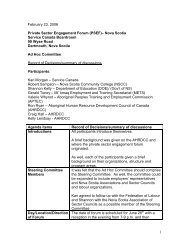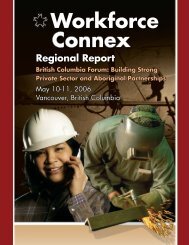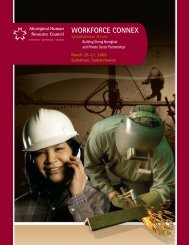Workforce connex - Aboriginal Human Resource Council
Workforce connex - Aboriginal Human Resource Council
Workforce connex - Aboriginal Human Resource Council
- No tags were found...
You also want an ePaper? Increase the reach of your titles
YUMPU automatically turns print PDFs into web optimized ePapers that Google loves.
•••••••••••••••••••Wage reimbursement program is available for up to 40 weeks:—————how do I know this is an employer? The information seemsto be tucked away in a government websiteprogram is client based – the person has to be a client on reserve.Service Canada website has all the information that you requireFirst Nations have employment counselors (16 in the province),they are grouped into AHRDAsneed to make the connect with the AHRDA (some infoon the AHRDA program)as an educator/employer, do I ask the client if they are awareof the program subsidy?— the problem is that the employers don’t now about all these programs.Clients needs to be job ready — the AHRDA isbased on interventions with the clients.You need to sort out bureaucracy in the different areas/lands.Should clients have written information about the AHRDA?If you have jobs as employers, do you have job ready people?Literacy program in Miramichi – there is a gap with the minimumrequirements and getting the person able to meet.What skills do you need for this job – a new certificateis available from the Department of Training.Issues of barriers – income is tax exempt.The issue is really finding the quality worker.What does business need to know:— AHRDAs – who/where/what does it do (roles and expectations)— to connect with AHRDAs – know their communities— how do employers find out about AHRDAs?Need to know geographical scope of job (i.e., local/regional).Employers prefer to use established human resourcesprocesses (ads) and potential employees come to them.Some employment and training officers check adsbut large First Nations don’t have time.Some sectors have employment equity requirements and haveactive recruitment of minorities (anyone federally regulated).Some businesses use targeted postings.Sent to professional associations; in tax bills, (increase profile).Some First Nations won’t have reserve for jobs; someclients weren’t ready; some are limited by age, familyobligation, education, support network off-reserve).Could relocate businesses to reserve.Have to sell destination/job to First Nations.••••••Why do some leave and some won’t?Need to work with youth to sell destination/options.Employer should make their workplace more of a ‘family’;must find success stories to motivate clients/youth.Businesses might use liaison; find mentors to work with First Nations.New Brunswick Association of Career Colleges:looking from Department of Fisheries and Oceans to providemarine diesel mechanics (reference: Mark Standing)— client needs assessment (reference: Moncton – Wade Wheaton)— need dollars to do thisroad builders training – two programs, one seat is reserved for FirstNations person in each program (reference: Mark Standing)— paving and bridge construction.Irving:more direct control with employment and training officers withregard to career opportunities (reference: Richel Grazdowsky)Ulnooweg Development Group - Penny Polchiesto co-ordinate a subcommitteeAlfred Sock – find employers who are willing to hire <strong>Aboriginal</strong> people– discuss what training they need and then provide trainingJoint Economic Development Initiative - Penny – see ifthey will advertise job opportunities on/off reserve.PART 5: KeynoteA joint presentation was done by Cheryl Knockwood, Senior Policy Analyst,Atlantic Policy Congress of First Nations Chiefs and Penny Polchies, CommunityEconomic Development Advisor, Ulnooweg Development Group. The title of theirpresentation was Atlantic <strong>Aboriginal</strong> Economy Building Strategy/Blueprint 2007.The presentation focused on the assets of <strong>Aboriginal</strong> people in AtlanticCanada (e.g., population of 35,000 in 35 communities, young, increasinglyeducated, and growing population, managing annual budgets of $375M(2001-02) and $439M (2005-06) and reserve lands of 30,000 hectares).The strategy/blueprint document highlighted some of the visions for the future:•••••——————Self-sufficient communities, people on/off reserves.Reduce poverty levels, fewer health and social problems.Educated and skilled <strong>Aboriginal</strong> labour force.Strong regional partnership for reserves/business development on/off reserves.Diversified and vertically integrated Atlantic <strong>Aboriginal</strong> economy.The strategy’s primary goals consisted of:• Property and resource development.<strong>Aboriginal</strong> <strong>Human</strong> <strong>Resource</strong> <strong>Council</strong> New Brunswick <strong>Workforce</strong> Connex Report 15









